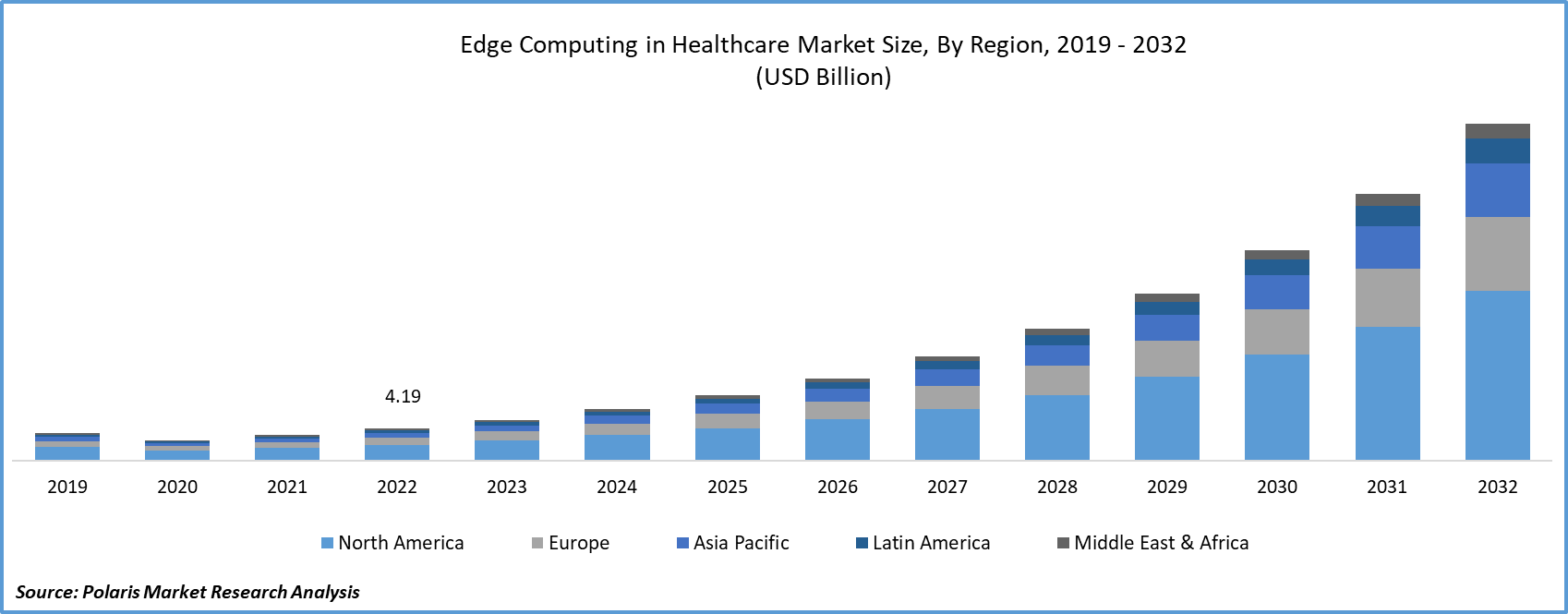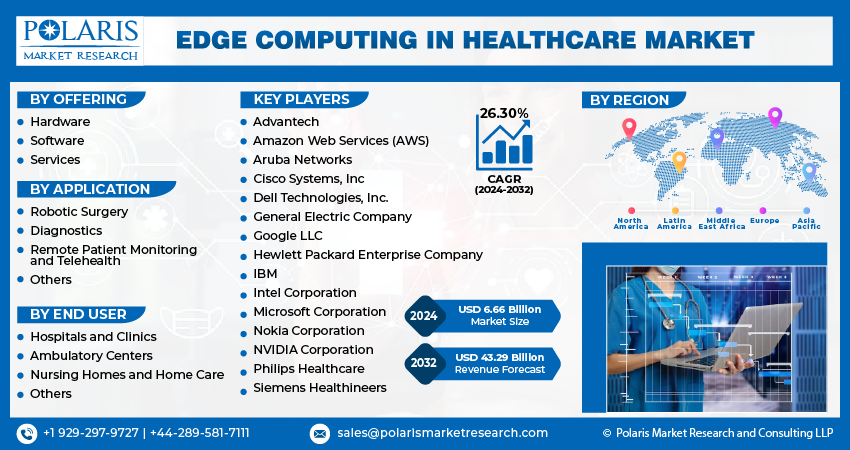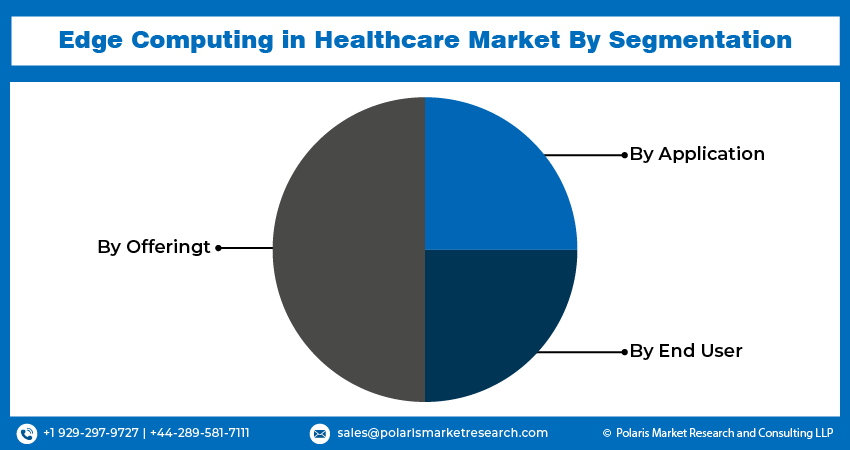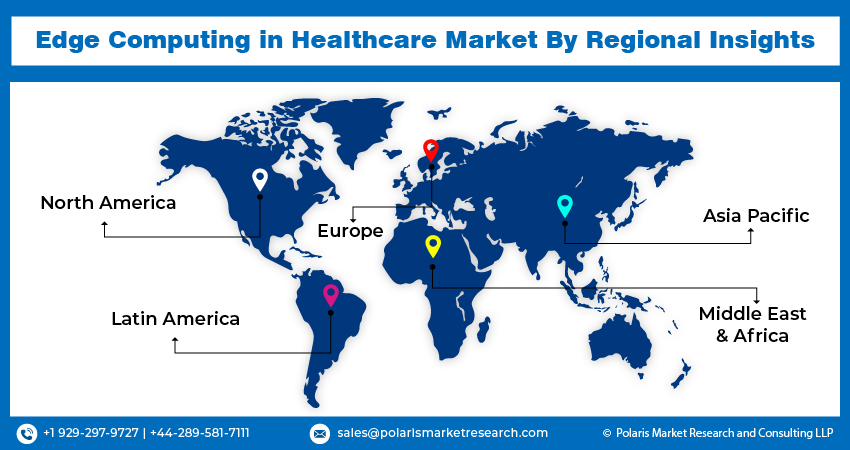
Edge Computing in Healthcare Market Share, Size, Trends, Industry Analysis Report, By Offering (Hardware, Software, Services); By Application; By End User; By Region; Segment Forecast, 2024- 2032
- Published Date:Jan-2024
- Pages: 116
- Format: PDF
- Report ID: PM4034
- Base Year: 2023
- Historical Data: 2019-2022
Report Outlook
The global edge computing in healthcare market was valued at USD 5.28 billion in 2023 and is expected to grow at a CAGR of 26.30% during the forecast period.
The research report offers a quantitative and qualitative analysis of the edge computing in healthcare market to enable effective decision-making. It covers the key trends and growth opportunities anticipated to have a favorable impact on the market. Besides, the study covers segment and regional revenue forecasts for market assessment.
Edge devices process data from the Internet of Things (IoT) for asset tracking, environmental monitoring, and equipment maintenance. This application optimizes hospital efficiency, reduces downtime, and enhances patient safety. Edge computing systems manage electronic health records (EHRs) in hospitals, allowing physicians secure and rapid access to patient data. This integration streamlines healthcare workflows and improves patient care, including the accuracy of diagnoses and treatment plans.

To Understand More About this Research: Request a Free Sample Report
Hospitals employ edge computing to power patient engagement solutions. By granting patients real-time access to their health data, this technology allows them to actively participate in their care plans actively, fostering a stronger sense of empowerment and involvement in their healthcare journey.
In addition, companies operating in the edge computing in healthcare market are entering partnerships and collaborations to cater to the growing demand.
- For instance, in March 2023, NVIDIA collaborated with Medtronic for development of AI in the healthcare system. The companies will integrate NVIDIA healthcare and edge AI technologies into Medtronic’s GI Genius intelligent endoscopy module.
The growing concern for data security and privacy in healthcare underscores the adoption of edge computing. By keeping sensitive patient information localized, edge computing reduces the vulnerability to data breaches and supports healthcare providers in adhering to strict privacy regulations like the Health Insurance Portability and Accountability Act (HIPAA).

The increasing prevalence of chronic diseases requires robust remote patient monitoring. Edge computing fulfills this need by efficiently processing and transmitting data from wearable devices and medical sensors, thus empowering healthcare professionals to manage chronic conditions more effectively. Government initiatives and funding for healthcare digitization, telehealth expansion, and the widespread adoption of electronic health records (EHRs) further fuel the need for edge computing infrastructure. These initiatives are aimed at bringing healthcare delivery into the digital age, improving accessibility and quality of care.
Growth Drivers
- Greater focus on patient safety, expansion of telehealth services, and adoption of Internet of Things is projected to spur the market demand
The imperative for real-time data processing is driven by the critical need for healthcare professionals to have immediate access to patient data. This is particularly crucial in intensive care scenarios, where split-second decisions can be life-saving.
The rapid expansion of telehealth services, accelerated by the COVID-19 pandemic, necessitates low-latency data transmission. Edge computing is essential in providing seamless, high-quality video consultations, remote patient monitoring, and diagnostics.
The proliferation of Internet of Things (IoT) devices in healthcare, including wearables and medical sensors, mandates edge computing for efficient processing of the immense data generated by these devices. This encompasses data from wearable health trackers, connected medical devices, and environmental sensors.
Report Segmentation
The market is primarily segmented based on offering, application, end user, and region.
|
By Offering |
By Application |
By End User |
By Region |
|
|
|
|
To Understand the Scope of this Report: Speak to Analyst
By Offering Analysis
- Hardware accounted for a significant market share in 2022
The hardware segment accounted for a significant share in 2022. Hardware for edge computing in healthcare is a critical component in ensuring the effective deployment of this technology within healthcare settings. Edge computing in healthcare relies heavily on IoT sensors. These include temperature sensors, blood pressure monitors, glucose meters, and other data collection devices. Hardware accelerators such as GPUs and TPUs are used for AI and machine learning tasks in healthcare, speeding up the processing of complex algorithms for tasks like medical image analysis. For telehealth and remote consultations, high-definition cameras are essential for clear video conferencing and medical imaging. Local storage is often needed for edge devices to cache data before transmitting it to the central server. Network-attached storage (NAS) devices may be used for this purpose.
By Application Analysis
- Remote patient monitoring and telehealth accounted for a significant market share in 2022
The remote patient monitoring and telehealth segment accounted for a significant share in 2022. Telehealth and remote patient monitoring rely on instantaneous data transmission and communication. Edge computing minimizes data transfer delays, enabling healthcare professionals to interact with patients in real time, regardless of their geographical locations. Edge computing ensures that sensitive patient information is processed and transmitted securely, reducing the risk of data breaches and preserving patient confidentiality. Many remote patient monitoring devices and telehealth tools leverage the Internet of Things (IoT). Edge computing seamlessly integrates with these IoT devices, ensuring efficient and effective data processing. Edge computing empowers patients by granting them access to their health data in real time. Patients can actively participate in their healthcare decisions, monitor their conditions, and make informed choices about their well-being.
By End User Analysis
- Hospitals and clinics held significant market revenue share in 2022
The hospitals and clinics segment accounted for a significant share in 2022. Edge computing empowers hospitals to engage in real-time patient monitoring by seamlessly processing data collected from wearable devices and medical sensors. This capability ensures continuous surveillance of patients, facilitates the swift identification of critical changes in health conditions and ultimately enhances patient outcomes. Edge computing expedites the processing and analysis of medical images, encompassing X-rays, MRIs, and CT scans. This advancement allows radiologists and physicians to access and interpret images with unparalleled speed, thereby facilitating faster diagnoses and more expeditious treatment decisions.

Regional Insights
- Asia-Pacific is expected to experience significant growth during the forecast period
Asia-Pacific is expected to experience significant growth during the forecast period. Edge computing is ushering in a new era of patient-centric healthcare in Asia-Pacific. Real-time data processing at the edge enables continuous remote monitoring of patients. This empowers healthcare providers to deliver more personalized care plans, ensuring timely interventions and improved patient outcomes. The telemedicine landscape is expanding across Asia-Pacific, and edge computing is at its core. By facilitating seamless video consultations, remote diagnostics, and secure data transmission, edge computing is making healthcare more accessible, especially in remote and underserved areas. It enables rapid analysis and transfer of large image files from devices like X-rays, MRIs, and CT scans, leading to swift and accurate diagnosis and treatment.
North America emerged as the largest region in 2022. The pandemic accelerated telehealth adoption in the U.S., and edge computing is integral to this transformation. It ensures secure, low-latency video consultations, swift data transfers, and remote patient monitoring, thereby enhancing healthcare accessibility. The healthcare sector generates immense data daily, from electronic health records to medical imaging. Edge computing empowers healthcare institutions to process and analyze this data at its origin, providing real-time insights and alleviating the load on central data centers. The proliferation of IoT and wearable tech in healthcare generates vast data streams. Edge computing processes this data locally, supporting timely patient monitoring and chronic disease management.

Key Market Players & Competitive Insights
The edge computing in healthcare market is marked by its fragmented nature, anticipating increased rivalry owing to the abundance of industry participants. Key contenders in this market consistently introduce inventive offerings to strengthen their market foothold. These companies place significant emphasis on forming partnerships, improving products, and engaging in collaborative endeavors to establish a competitive edge over their peers and secure a substantial market share.
Some of the major players operating in the global market include:
- Advantech
- Amazon Web Services (AWS)
- Aruba Networks
- Cisco Systems, Inc
- Dell Technologies, Inc.
- General Electric Company
- Google LLC
- Hewlett Packard Enterprise Company
- IBM
- Intel Corporation
- Microsoft Corporation
- Nokia Corporation
- NVIDIA Corporation
- Philips Healthcare
- Siemens Healthineers
Recent Developments
- In July 2022, GE Healthcare unveiled its 5G Innovation Hub in India. This facility, the GE Healthcare 5G Innovation Hub, is set to act as a hub for the convergence of transformative technologies, including AI/ML, IoT, Big Data, Edge Computing, and Cybersecurity.
- In March 2022, NVIDIA launched Clara Holoscan MGX, a dedicated platform tailored for the medical device sector. This platform empowers the development and deployment of real-time AI applications while strictly adhering to essential regulatory standards. It represents a significant advancement in sensor technology for edge computing, facilitating the processing of high-throughput data streams to deliver immediate, actionable insights.
Edge Computing in Healthcare Market Report Scope
|
Report Attributes |
Details |
|
Market size value in 2024 |
USD 6.66 billion |
|
Revenue forecast in 2032 |
USD 43.29 billion |
|
CAGR |
26.30% from 2024 – 2032 |
|
Base year |
2023 |
|
Historical data |
2019-2022 |
|
Forecast period |
2024 – 2032 |
|
Quantitative units |
Revenue in USD billion and CAGR from 2024 to 2032 |
|
Segments covered |
By Offering, By Application, By End User, By Region |
|
Regional scope |
North America, Europe, Asia Pacific, Latin America; Middle East & Africa |
|
Customization |
Report customization as per your requirements with respect to countries, region and segmentation. |
Delve into the intricacies of edge computing in healthcare in 2024 through the meticulously compiled market share, size, and revenue growth rate statistics by Polaris Market Research Industry Reports. Uncover a comprehensive analysis that not only projects market trends up to 2029 but also provides valuable insights into the historical landscape. Immerse yourself in the depth of this industry analysis by acquiring a complimentary PDF download of the sample report.
Browse Our Top Selling Reports
HERG Screening Market Size, Share 2024 Research Report
AI in Oncology Market Size, Share 2024 Research Report
Research Grade Proteins Market Size, Share 2024 Research Report
Term Insurance Market Size, Share 2024 Research Report
Healthcare Data Integration Market Size, Share 2024 Research Report
